Tire microplastic particles and warming inhibit physiological functions of the toxic microalga Alexandrium pacificum
IF 12.2
1区 环境科学与生态学
Q1 ENGINEERING, ENVIRONMENTAL
引用次数: 0
Abstract
Previous studies have confirmed that the tire microplastic particles (TMPs) have a variety of toxic biological effects. However, the potential toxic mechanisms of TMPs remain to be elucidated, especially in the interaction between particle behavior and seawater warming. In this study, we investigated the effects of three different concentrations of TMPs suspensions (0 mg/L, 1 mg/L, and 500 mg/L) on Alexandrium pacificum in both the presence and absence of warming. Our results revealed significant differences in toxicity among different concentrations of TMPs towards A. pacificum, i.e., low concentrations promoting but high concentrations inhibiting, furthermore, warming exacerbated these toxicological responses. Specifically, under elevated temperature, high concentrations TMPs could inhibit photosynthetic pigment and chlorophyll fluorescence parameter, as well as the nutrient absorption, and induced oxidative stress. Furthermore, TMPs could adsorb onto microalgae surfaces and thus, forming heterogeneous aggregates through agglomeration with extracellular secretions. This is strongly correlated with biomarker response. Overall, these findings highlight the influence of warming on the toxicity of TMPs and provide valuable data for risk assessment.

轮胎微塑料颗粒和升温抑制有毒微藻亚历山大太平洋藻的生理功能
以往的研究证实,轮胎微塑料颗粒(TMPs)具有多种有毒生物效应。然而,TMPs 的潜在毒性机制仍有待阐明,尤其是颗粒行为与海水变暖之间的相互作用。在本研究中,我们研究了三种不同浓度的 TMPs 悬浮液(0 毫克/升、1 毫克/升和 500 毫克/升)在海水升温和不升温的情况下对太平洋亚历山大藻的影响。我们的研究结果表明,不同浓度的 TMPs 对太平洋赤潮的毒性存在明显差异,即低浓度具有促进作用,而高浓度则具有抑制作用。具体而言,在温度升高的条件下,高浓度的 TMPs 会抑制光合色素和叶绿素荧光参数以及营养吸收,并诱发氧化应激。此外,TMPs 还能吸附在微藻表面,从而与细胞外分泌物凝集形成异质聚集体。这与生物标记反应密切相关。总之,这些研究结果突显了气候变暖对 TMPs 毒性的影响,并为风险评估提供了宝贵的数据。
本文章由计算机程序翻译,如有差异,请以英文原文为准。
求助全文
约1分钟内获得全文
求助全文
来源期刊

Journal of Hazardous Materials
工程技术-工程:环境
CiteScore
25.40
自引率
5.90%
发文量
3059
审稿时长
58 days
期刊介绍:
The Journal of Hazardous Materials serves as a global platform for promoting cutting-edge research in the field of Environmental Science and Engineering. Our publication features a wide range of articles, including full-length research papers, review articles, and perspectives, with the aim of enhancing our understanding of the dangers and risks associated with various materials concerning public health and the environment. It is important to note that the term "environmental contaminants" refers specifically to substances that pose hazardous effects through contamination, while excluding those that do not have such impacts on the environment or human health. Moreover, we emphasize the distinction between wastes and hazardous materials in order to provide further clarity on the scope of the journal. We have a keen interest in exploring specific compounds and microbial agents that have adverse effects on the environment.
 求助内容:
求助内容: 应助结果提醒方式:
应助结果提醒方式:


